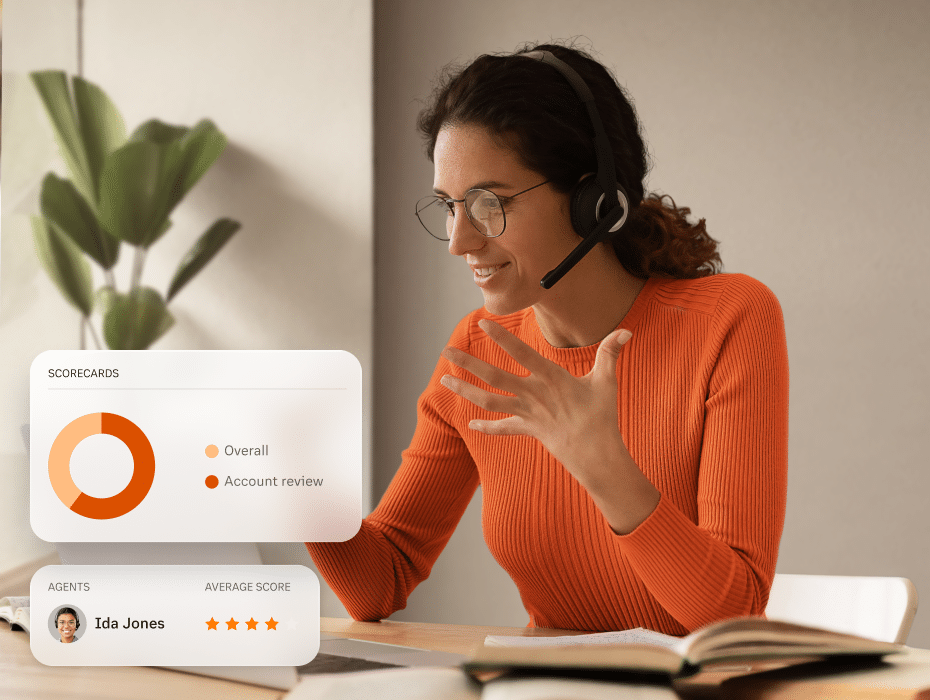As your business grows, you might feel overwhelmed by the number of incoming calls from customers. There might be a bunch of people sitting on hold, or maybe missed calls are stacking up. While this is a great problem to have, it’s still a problem. That’s where advanced call routing comes (ACR) in.
If you’re new to ACR, you’ve come to the right place. We’ve rounded up all the details you need to start using this powerful tool for your small business.
Today, we’ll cover:
👀 How do businesses like yours use advanced call routing? Find out in the free Contact Center Playbook.
What is advanced call routing?
Basic call routing is a call management process that automatically queues and distributes incoming calls based on a predefined set of rules and criteria. Advanced call routing is cloud-based, powered by AI, and capable of routing calls to multiple channels for self-service or live agent support.
Advanced call routing helps you keep existing customers and attract new customers by improving the call queue experience. When a caller tries to reach your call center, the phone system will route their incoming call to the right agent. The call calling system automates this process so your agents can focus on managing the call volume.
How advanced call routing works
Advanced call routing generally follows a two-step process:
- The incoming call goes to an interactive voice response tool (IVR), where answers to a series of automated questions help determine the caller’s purpose. If you ever called a phone number and got “Tell us why you are calling?” or “Press 1 for store hours,” you have used that company’s IVR.
- Based on the caller’s responses, the automatic call distributor (ACD) sends the call to the most appropriate or available agent. The ACD can be pre-set to route calls based on the criteria you choose.
8 benefits of advanced call routing
There are many benefits to using call routing systems to make your business’s call center solution more reliable and reachable by both domestic and international calling for inbound calls. You can support your business by using smart call routing strategies. Manage calls routed from global customers calling outside of business hours, route calls to multiple locations, and ensure that every call gets answered by the right department.
Using an advanced call routing solution can:
- Reduce wait times, missed calls, and call abandonment
- Get your customers to the right person more quickly
- Reduce the amount of missed calls
- Allow you to offer global support
- Give your business a human touch with custom greetings
- Enable self-service options
- Balance your workloads more efficiently
- Improve customer satisfaction
Let’s take a look at these benefits one by one.
1. Reduce wait time and call abandonment
Advanced call routing allows you to manage incoming calls in several ways. You can allow calls to ring on multiple phones at the same time, so anyone who is available can pick it up, ensuring the call gets answered quickly. You can send calls through a list of predetermined employees, so when one is busy, it moves on to the next. Both of these solutions reduce wait times. Here’s how this looks in RingCentral Contact Center:

The less time a caller spends waiting, the less likely they are to abandon the call, meaning customers get their questions answered more quickly and completely. This leads to greater customer satisfaction.
2. Route calls to the right department, the first time
A smart call routing system will identify the type of call by interacting with the caller via an advanced IVR system and the appropriate routing options. Once the system discerns the purpose of the call, it will transfer the caller to the appropriate department, employee, or agent for help. This enables your business to:
- Connect callers to employees in their location and time zone
- Match callers with agents they’ve spoken to previously
- Connect callers to self-service options if that is their preference
This is known as skills-based routing. It enhances the customer experience with smooth transfers and ensures they are speaking to the agent best able to help them. And that could mean a real improvement in your first call resolution rate.

3. Reduce missed calls
In the age of remote and hybrid work, even small businesses can access a global talent pool. This has lots of benefits, especially when it comes to advanced call routing. Because you can route calls to different office locations, it’s easy to connect callers to team members that work in other time zones. You can guarantee callers get support and your employees won’t have to work a second shift or overtime.
By answering calls during “non-business” hours, you will reduce the number of missed or unanswered calls.
4. Offer global support
When you set up call routing for your business, you can develop a global customer support strategy, which makes your business accessible to customers all over the world, no matter where they are.
When forwarding international calls to a different location, you can avoid international calling fees while routing callers to an office in any location. This combination of services improves your support system for customers around the globe.
5. Use custom greetings
Custom greetings pre-recorded by actual humans, not automated messages, help your customers navigate your business phone system. These messages can let them know about company updates, new features and services, and additional information. Use these custom greetings for certain types of callers using caller ID to determine where they’re calling from. You can even record holiday greetings based on location. This will give your business a human touch.
6. Set up voicemail and self-service tools
Leaving customers waiting is always a bad idea. Letting them leave a voicemail when all agents are busy ensures that as soon as an agent is available, they will get a call back. This reduces wait times on the phone so the customer can move on and still count on you to solve their problem.
Pre-recorded messages inform callers to submit a ticket or view online support guides on their own. Self-service options allow your customers to take control of their own support experience. They’ll find the assistance they need quickly on their own and won’t have to talk to anyone on the phone.
You may also build troubleshooting into your IVR system with answers to the most common questions. It then follows a set of routing rules to direct callers to the appropriate recorded message.
7. Balance workloads
Effective call routing solutions distribute calls evenly among employees, resulting in a more balanced workload. Your employees won’t be overwhelmed with multiple calls while other employees remain idle. You can manage higher call volumes with this strategy and maintain efficiency.
8. Boost customer satisfaction
Every strategy listed above helps to achieve improved customer satisfaction. Your business will:
- Offer more effective customer support
- Be more responsive and reliable
- Gain more loyal customers
- Increase efficiency
Your customers are more likely to stick around when they know they’ll get a prompt answer to their question, and you’ll be able to gain new customers as well as retain customers for much longer.
Get advanced call routing for your business today
Optimize your communications with an advanced call routing system so you can answer questions more efficiently, offer support globally, provide a variety of self-service options, and provide your customers with that all-important personal touch. By developing strategies to improve your call routing, you’ll notice marked results in workforce management and customer satisfaction.
Advanced call routing is just one feature of RingCentral’s inbound call center solution. Find out how to offer effortless customer engagement with RingCentral today.
Originally published Dec 16, 2021, updated Jun 17, 2024





